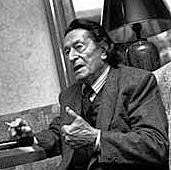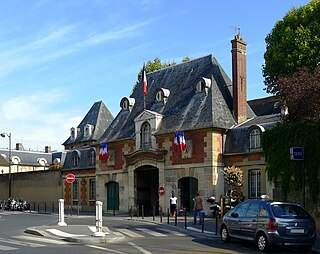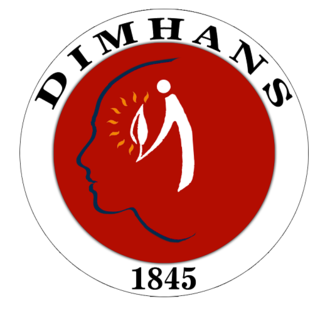
Psychiatric hospitals, also known as mental health hospitals or behavioral health hospitals, are hospitals or wards specializing in the treatment of severe mental disorders, including schizophrenia, bipolar disorder, eating disorders, dissociative identity disorder, major depressive disorder, and others.

Henri Laborit was a French surgeon, neurobiologist, writer and philosopher. In 1952, Laborit was instrumental in the development of the drug chlorpromazine, published his findings, and convinced three psychiatrists to test it on a patient, resulting in great success. Laborit was recognized for his work, but as a surgeon searching for an anesthetic, he came to be at odds with psychiatrists who made their own discoveries and competing claims.

Hôpital de la Charité was a hospital in Paris founded by the Brothers Hospitallers of St. John of God in the 17th century. In 1935, it was closed and demolished to make way for the new faculty of medicine. Located at 45, rue des Saints-Pères, the premises currently house the Centre Universitaire des Saints-Pères, one of the sites of the University of Paris-Descartes.

The Hôtel-Dieu is a public hospital located on the Île de la Cité in the 4th arrondissement of Paris, on the parvis of Notre-Dame. Tradition has it that the hospital was founded by Saint Landry in 651 AD, but the first official records date it to 829, making it the oldest in France and possibly the oldest continuously operating hospital in the world. The Hôtel-Dieu was the only hospital in the city until the beginning of the 17th century.

Deinstitutionalisation is the process of replacing long-stay psychiatric hospitals with less isolated community mental health services for those diagnosed with a mental disorder or developmental disability. In the late 20th century, it led to the closure of many psychiatric hospitals, as patients were increasingly cared for at home, in halfway houses and clinics, in regular hospitals, or not at all.

The Centre hospitalier de l'Université de Montréal is one of two major healthcare networks in the city of Montreal, Quebec. It is a teaching institution affiliated with the French-language Université de Montréal. The CHUM is one of the largest hospitals in Canada; a public not-for-profit corporation, it receives most of its funding from Quebec taxpayers through the Ministry of Health and Social Services as mandated by the Canada Health Act. The CHUM's primary mission is to provide inpatient and ambulatory care to its immediate urban clientele and specialized and ultraspecialized services to the broader metropolitan and provincial population. Its mandate also includes pure and applied research, teaching, and the evaluation of medical technology and best healthcare practices. Every year, more than 500,000 patients are admitted for care at the CHUM.

Jean-Étienne Dominique Esquirol was a French psychiatrist.

Jean-Pierre Falret was a French psychiatrist. He was born and died in Marcilhac-sur-Célé.

The Valkenberg Hospital is a large, government-funded, tertiary psychiatric hospital in the city of Cape Town, South Africa.
Psychiatry is the medical specialty devoted to the diagnosis, prevention, and treatment of deleterious mental conditions. These include various matters related to mood, behaviour, cognition, and perceptions.
This is a timeline of the modern development of psychiatry. Related information can be found in the Timeline of psychology and Timeline of psychotherapy articles.

Hôpital Saint-Louis is a hospital in Paris, France. It was built in 1611 by architect Claude Vellefaux at the request of Henry IV of France. It is part of the Assistance publique - Hôpitaux de Paris hospital system, and it is located at 1 avenue Claude-Vellefaux, in the 10th arrondissement near the metro station Goncourt.

Jean Delay was a French psychiatrist, neurologist, writer, and a member of the Académie française.

The lunatic asylum, insane asylum or mental asylum was an early precursor of the modern psychiatric hospital.

St. Brendan's Hospital was a psychiatric facility located in the north Dublin suburb of Grangegorman. It formed part of the mental health services of Dublin North East with its catchment area being North West Dublin. It is now the site of a modern mental health facility known as the "Phoenix Care Centre". Since the official opening of the Richmond Lunatic Asylum in 1815 the Grangegorman site has continuously provided institutional facilities for the reception of the mentally ill until the present day. As such the Phoenix Care Centre represents the continuation of the oldest public psychiatric facility in Ireland.
Henri Dagonet was a French psychiatrist.

Institut universitaire en santé mentale de Montréal is a psychiatric hospital in Montreal, Quebec, Canada. It is located at 7401 Hochelaga Street in the borough of Mercier–Hochelaga-Maisonneuve. It was established in 1873 and is affiliated with the Université de Montréal Faculty of Medicine.
The Geneva University Hospitals is one of the five university hospitals of Switzerland and the largest one in the country. It is one of the largest hospitals in Europe.
Marion Leboyer is a French psychiatrist, university professor and hospital practitioner at the Paris-Est Créteil University (UPEC).

Dharwad Institute of Mental Health and Neurosciences (DIMHANS) is a public medical institution in Dharwad, Karnataka, India, which provides healthcare facilities specializing in Mental Health, Psychiatry and Neuroscience. Additionally, DIMHANS offers several Post-Graduate academic programs.


![The hospital on the plan of Jouvin de Rochefort [fr], in 1672 Hospital Sainte Anne pour les malades de contagion, plan Jouvin de Rochefort, 1672.jpg](http://upload.wikimedia.org/wikipedia/commons/thumb/b/b2/Hospital_Sainte_Anne_pour_les_malades_de_contagion%2C_plan_Jouvin_de_Rochefort%2C_1672.jpg/220px-Hospital_Sainte_Anne_pour_les_malades_de_contagion%2C_plan_Jouvin_de_Rochefort%2C_1672.jpg)

![The Sainte-Anne Chapel [fr], built by Charles-Auguste Questel in 1869 Chapelle du Centre Hospitalier Sainte-Anne construite (1869) par l'architecte Charles Auguste Questel.jpg](http://upload.wikimedia.org/wikipedia/commons/thumb/7/74/Chapelle_du_Centre_Hospitalier_Sainte-Anne_construite_%281869%29_par_l%27architecte_Charles_Auguste_Questel.jpg/220px-Chapelle_du_Centre_Hospitalier_Sainte-Anne_construite_%281869%29_par_l%27architecte_Charles_Auguste_Questel.jpg)
![Gate No. 1, Rue Cabanis [fr] P1110093 Paris XIII rue Cabanis entree hopital Sainte-Anne rwk.JPG](http://upload.wikimedia.org/wikipedia/commons/thumb/5/57/P1110093_Paris_XIII_rue_Cabanis_entr%C3%A9e_h%C3%B4pital_Sainte-Anne_rwk.JPG/220px-P1110093_Paris_XIII_rue_Cabanis_entr%C3%A9e_h%C3%B4pital_Sainte-Anne_rwk.JPG)

![Le Guet, a statue by Victorien Tournier [fr] (1900), was placed in the garden of the Sainte-Anne Hospital in Paris in 1947. Le Guet by Victor Tournier, Hopital Sainte-Anne 02 (2).jpg](http://upload.wikimedia.org/wikipedia/commons/thumb/4/49/Le_Guet_by_Victor_Tournier%2C_H%C3%B4pital_Sainte-Anne_02_%282%29.jpg/150px-Le_Guet_by_Victor_Tournier%2C_H%C3%B4pital_Sainte-Anne_02_%282%29.jpg)














